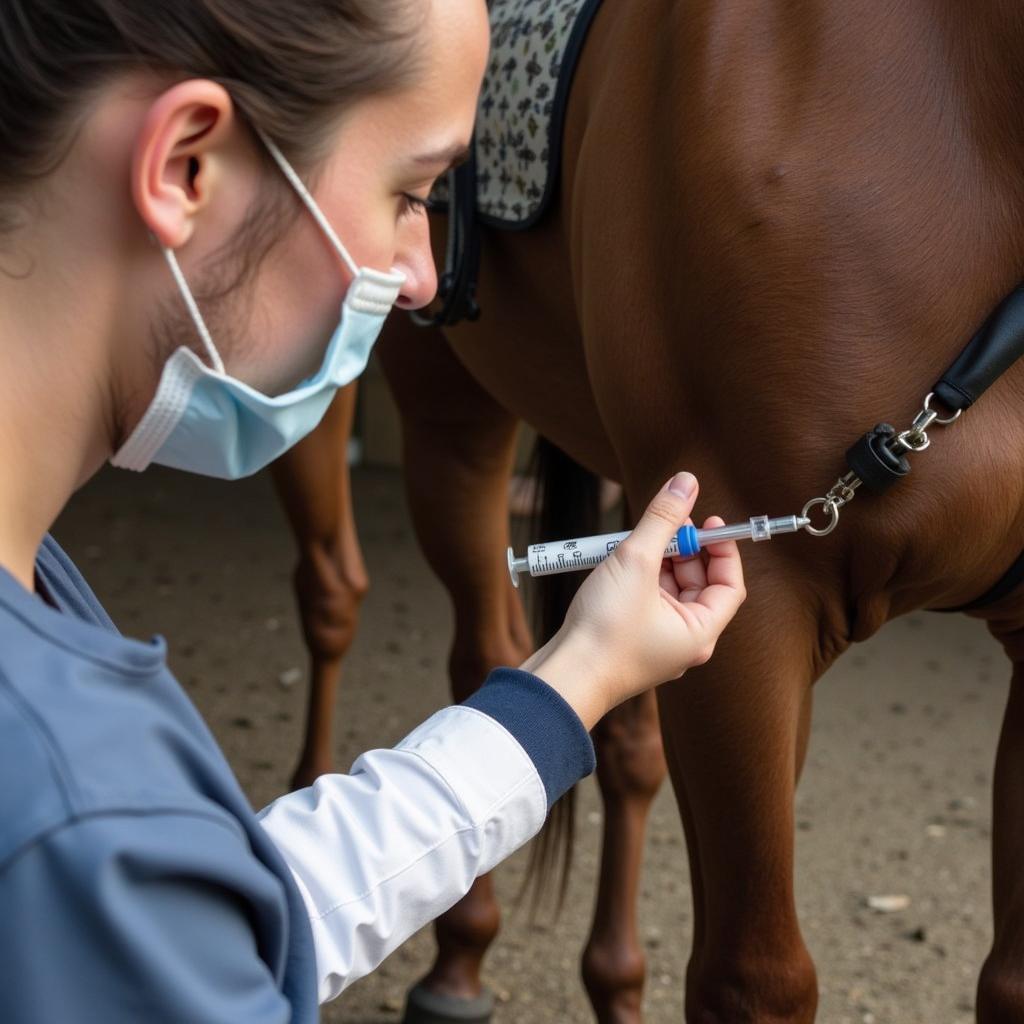Horse Stifle Problems are a common concern for horse owners, impacting a horse’s mobility and overall well-being. From subtle stiffness to noticeable lameness, stifle issues can manifest in various ways, requiring careful diagnosis and appropriate management. This article delves into the intricacies of horse stifle problems, exploring their causes, symptoms, diagnostic methods, and treatment options.
What Causes Stifle Problems in Horses?
Stifle problems in horses arise from a variety of factors, including conformation, trauma, and degenerative conditions. Conformation, particularly straight hind limbs or offset knees, can predispose a horse to stifle instability. Traumatic injuries, such as kicks, falls, or excessive strain during exercise, can damage ligaments, tendons, and other structures within the stifle joint. Degenerative diseases, like osteoarthritis, gradually wear down cartilage, leading to pain, inflammation, and restricted movement.
Recognizing the Symptoms of Horse Stifle Issues
Identifying stifle problems in horses requires keen observation. Symptoms can range from mild to severe and may include:
- Lameness, particularly when starting or turning
- Swelling around the stifle joint
- Difficulty flexing or extending the leg
- Pain or discomfort when the stifle is touched
- A clicking or popping sound in the joint
- Dragging the toe
- Reluctance to engage in activities such as jumping or running
If you observe any of these symptoms in your horse, it’s crucial to consult a veterinarian for a proper diagnosis and treatment plan. horse with stifle issues
Diagnosing Horse Stifle Problems: A Veterinarian’s Approach
Veterinarians employ various methods to diagnose horse stifle problems accurately. A thorough physical examination assesses the horse’s gait, range of motion, and palpation of the stifle joint. Diagnostic imaging, such as X-rays and ultrasound, provide detailed views of the joint’s internal structures, revealing fractures, ligament tears, and cartilage damage. In some cases, joint fluid analysis may be necessary to evaluate the presence of infection or inflammation.
Treatment Options for Horse Stifle Problems
Treatment for horse stifle problems varies depending on the underlying cause and severity of the condition. Conservative management may involve rest, anti-inflammatory medications, and physical therapy. More severe cases might require surgical intervention to repair damaged ligaments or remove bone fragments. stifle of a horse
“Early intervention is key in managing stifle problems,” emphasizes Dr. Emily Carter, DVM, specializing in equine sports medicine. “The sooner a diagnosis is made, the more effective treatment options can be.”
Preventing Horse Stifle Problems
While not all stifle problems are preventable, certain measures can reduce the risk:
- Maintain a healthy weight for your horse to minimize stress on the joints.
- Provide a balanced diet that supports joint health.
- Ensure proper warm-up and cool-down routines before and after exercise.
- Avoid overexertion or repetitive strain on the stifle joint.
- Maintain a safe and consistent riding surface.
 Horse Receiving Stifle Treatment
Horse Receiving Stifle Treatment
Can Stifle Issues be Completely Resolved?
The prognosis for horse stifle problems depends on the specific condition and the individual horse. Some conditions, like minor sprains, may resolve completely with rest and conservative treatment. More severe injuries or degenerative diseases may require long-term management to control pain and maintain mobility. horse patella “Each case is unique,” notes Dr. Sarah Miller, DVM, an equine orthopedic surgeon. “It’s important to work closely with your veterinarian to develop a customized treatment plan and realistic expectations.” live cover horse
Conclusion
Horse stifle problems are a complex issue that requires careful attention and management. Understanding the causes, symptoms, and treatment options empowers horse owners to make informed decisions about their horse’s care. Early diagnosis and intervention are crucial for maximizing the chances of a successful outcome. By prioritizing preventative measures and seeking veterinary guidance when needed, horse owners can help keep their equine companions sound and comfortable. horse licking
FAQ
-
What is the most common stifle injury in horses? Upward patellar fixation and meniscal tears are common stifle injuries.
-
How can I tell if my horse has a stifle problem? Lameness, swelling, difficulty flexing the leg, and clicking sounds are potential signs.
-
What are the treatment options for a horse with stifle problems? Treatment varies from rest and medication to surgery, depending on the severity.
Common Situations and Questions:
-
Scenario: Your horse suddenly becomes lame after landing awkwardly from a jump. Question: What are the first steps you should take?
-
Scenario: Your older horse is showing signs of stiffness and difficulty moving, especially in the hindquarters. Question: What are the potential causes and how should they be addressed?
Further Exploration on JustusHorsesUSA:
-
Learn more about specific stifle conditions like upward patellar fixation and meniscus tears.
-
Explore articles on equine lameness and its various causes.
For any further assistance or inquiries regarding horse stifle problems, contact us at:
Phone: 0772127271
Email: [email protected]
Address: QGM2+WX2, Vị Trung, Vị Thuỷ, Hậu Giang, Việt Nam.
Our dedicated customer care team is available 24/7.